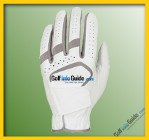
Golf glove: Necessity, or just one more item that drives up the cost of the game?
Speaking literally, you obviously don’t need a glove to hold and swing a club. Fred Couples plays without a glove and he’s done just fine.
The fact is, though, that the vast majority of professional and avid amateur golfers prefer playing with a glove on their left hand (or their right, if they’re left-handed). One pro, Tommy Gainey, loves gloves so much he wears one on each hand. Hence, his nickname: “Two Gloves.”
It’s easy to understand why wearing a glove is the way to go. For starters, a glove provides an extra layer of security between hand and handle. If the top hand slips during the swing, even just a smidgeon, disaster can strike.
A glove also helps prevent blisters on the left hand; unlike the right hand, the left is in total contact with the club and more susceptible to friction. A glove keeps slippery moisture and grime from building up between hand and club, too.
Many golfers believe a glove inhibits their feel with the putter, so they go gloveless on the greens. Jack Nicklaus is among those who keeps his glove on to putt.
Golf Glove Facts & Figures
Most golf gloves are made from an extremely soft, thin leather called cabretta. It’s made from the skin of hair sheep (as opposed to sheep which grow wool). Gloves made from synthetic leather, and hybrids of real and synthetic materials, are increasingly popular.
Most glove makers offer sizes from small to extra-large, and sometimes even larger. You’ll also come across the word “cadet” attached to glove sizes. Cadet gloves have shorter fingers than regular gloves of the same size; e.g., a cadet medium glove has the same palm fit with shorter fingers than a standard medium.
Gloves are made for men and women, though men enjoy a wider range of choices. Likewise, there are more models for the left hand (right-handed golfers) than for the right. White or off-white colors (e.g., pearl) are by far the most popular, though some companies offer black, blue and multi-colored models.
While the majority of gloves come with an “all-weather” label, a few are made specifically for rainy, hot or cold conditions.
Golf shoe giant FootJoy is also the market leader in golf glove production. The company enjoys the largest representation among tour pros and is No. 1 in gloves sales. Other big names in the glove business include equipment makers Callaway, TaylorMade, Nike and Wilson.
As for pricing, new gloves range from less than $10 for value models up to $30 or more for premium versions. To help you decide whether the investment is worth it, Golf-Info-Guide.com reviews current models from the top brands. We provide basic info on each glove (material, sizes, colors, etc.) and offer our thoughts on its comfort, feel, gripping power and appearance.
Check out this page whenever you’re shopping for a new golf glove. We’ll keep it fresh with reviews of the latest offerings.





